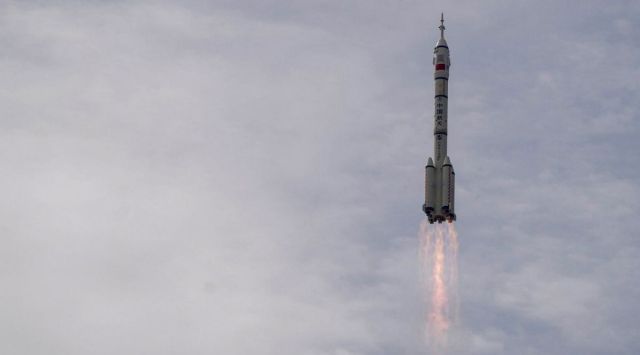චීනයේ වර්ධනය වෙමින් පවතින අභ්යවකාශ වැඩසටහන සඳහා සැලකිය යුතු ඉදිරි පිම්මක් ලෙස, රට සිය පස්වන කාර්ය මණ්ඩල මෙහෙයුම අඟහරුවාදා චීන අභ්යවකාශ මධ්යස්ථානය වෙත සාර්ථකව දියත් කරන ලදී. රාජ්ය මාධ්ය විසින් වාර්තා කරන ලද පරිදි, ගගනගාමීන් තිදෙනෙකු රැගත් Shenzhou-16 අභ්යවකාශ යානය, රාජ්ය මාධ්ය විසින් වාර්තා කරන ලද පරිදි, විශ්වාසදායක Long March-2F රොකට්ටුව මගින් තල්ලු කරන ලද, දේශීය වේලාවෙන් පෙරවරු 9:31 ට (GMT 0131 GMT) Gobi කාන්තාරයේ Jiuquan චන්ද්රිකා දියත් කිරීමේ මධ්යස්ථානයෙන් පිටත් විය. .
"දිව්ය යාත්රාව" ලෙස නම් කර ඇති Shenzhou-16 අභ්යවකාශ යානය, "Heavenly Palace" ලෙස ආදරයෙන් හඳුන්වන Tiangong අභ්යවකාශ මධ්යස්ථානය වෙත බැඳී ඇත. විද්යාත්මක ගවේෂණ සඳහා රසායනාගාර මොඩියුල දෙකක් සමඟින් වාසස්ථාන සහ වැඩ සඳහා මූලික මොඩියුලයකින් සමන්විත අභ්යවකාශ මධ්යස්ථානය, 2021 අප්රේල් මාසයේ ආරම්භ වූ මෙහෙයුම් 11 කින් පසුව 2022 දෙසැම්බර් මාසයේදී සාර්ථකව නිම කරන ලදී.
මෙහෙයුමට අණ දෙන ප්රවීණ ගගනගාමියෙකු වන ජිං හයිපෙන්ග් (56) වන අතර ඔහු මීට පෙර අභ්යවකාශ තරණයන් තුනක් ආරම්භ කර ඇත. ඔහුට සහය වන්නේ පියාසැරි ඉංජිනේරුවෙකු වන Zhu Yangzhu, 36, හිටපු හමුදා විශ්ව විද්යාල මහාචාර්යවරයෙකු සහ Beihang විශ්ව විද්යාලයේ මහාචාර්යවරයෙකු වන, Payload විශේෂඥ Gui Haichao, 36, වේ.
ඔවුන්ගේ මාස හයක රැඳී සිටීමේ කාලය තුළ, Shenzhou-16 කාර්ය මණ්ඩලය ජෛව තාක්ෂණය, වෛද්ය විද්යාව, භෞතික විද්යාව සහ තාරකා විද්යාව වැනි වැදගත් ක්ෂේත්ර ඇතුළත් පුළුල් පරාසයක විද්යාත්මක අත්හදා බැලීම් සිදු කරනු ඇත. මීට අමතරව, ඔවුන් නව තාක්ෂණයන් සහ උපකරණ පරීක්ෂාවට ලක් කරනු ඇත, අනාගත මෙහෙයුම් සඳහා මග පාදයි.
මෙම මෙහෙයුම චීන ගගනගාමීන් අභ්යවකාශ මධ්යස්ථානයේ ගත කළ දීර්ඝතම කාලසීමාව සනිටුහන් කරයි. Shenzhou-16 කාර්ය මණ්ඩලය නොවැම්බර් මාසයේදී නැවතුම්පොළට පැමිණි Shenzhou-15 හි පදිංචිකරුවන් වෙනුවට ඉක්මනින් පෘථිවියට පැමිණීමට අපේක්ෂා කෙරේ.
චීනයේ අභිලාෂකාමී අභ්යවකාශ වැඩසටහන මඟින් සැපයුම් නැවත පිරවීම සඳහා රොබෝ භාණ්ඩ ප්රවාහන නෞකාවක් දියත් කිරීමත් සමඟ මෙම වසර අගදී අභ්යවකාශ මධ්යස්ථානය වෙත තවත් කාර්ය මණ්ඩලයක් සහිත මෙහෙයුමක් සිදු කිරීම අරමුණු කරයි. තවද, 2023 අවසන් වන විට දුම්රිය ස්ථානයේ මෙහෙයුම් සමඟ සහයෝගයෙන් කටයුතු කරන අභ්යවකාශ දුරේක්ෂයක් යෙදවීමට ජාතිය සැලසුම් කරයි.
මෑත වසරවල කැපී පෙනෙන ප්රගතියක් අත්කරගෙන ඇති චීනය, එක්සත් ජනපදයේ සහ රුසියාවේ දිගුකාලීන ආධිපත්යයට අභියෝග කිරීමට උත්සාහ කරමින් අභ්යවකාශ ගවේෂණයේ ප්රබල බලවේගයක් ලෙස මතු වී තිබේ. සැලකිය යුතු කරුණක් නම්, චීනය සඳ සහ අඟහරු යන දෙඅංශයේම ගවේෂණ සාර්ථකව ගොඩ බැස ඇති අතර අභ්යවකාශ ගවේෂණයේ අනාගතය හැඩගස්වා ගැනීමේ එහි නිර්භීත අභිලාෂයන් අවධාරනය කරමින් 2030 වන විට ගගනගාමීන් චන්ද්ර පෘෂ්ඨයට යැවීමට අපේක්ෂා කරයි.
In a significant leap forward for China's burgeoning space program, the country successfully launched its fifth crewed mission to the Chinese space station on Tuesday. The Shenzhou-16 spacecraft, carrying a trio of astronauts, departed from the Jiuquan Satellite Launch Centre in the Gobi Desert at 9:31 a.m. local time (0131 GMT), propelled by the reliable Long March-2F rocket, as reported by state media.
The Shenzhou-16 spacecraft, aptly named "Divine Vessel," is bound for the Tiangong space station, lovingly dubbed the "Heavenly Palace." The space station, composed of a core module for habitation and work, alongside two laboratory modules for scientific exploration, was successfully completed in December 2022 after a series of 11 missions that began in April 2021.
Commanding the mission is veteran astronaut Jing Haipeng, 56, who has already embarked on three previous spaceflights. Assisting him are flight engineer Zhu Yangzhu, 36, a former military university professor, and payload specialist Gui Haichao, 36, a professor at Beihang University.
Over the course of their six-month stay, the Shenzhou-16 crew will conduct a wide array of scientific experiments encompassing vital fields such as biotechnology, medicine, physics, and astronomy. Additionally, they will put new technologies and equipment to the test, paving the way for future missions.
This mission marks the lengthiest duration that Chinese astronauts have spent aboard the space station. The Shenzhou-16 crew will replace the occupants of the Shenzhou-15, who arrived at the station in November and are expected to return to Earth shortly.
China's ambitious space program aims to undertake another crewed mission to the space station later this year, alongside launching a robotic cargo ship to replenish supplies. Furthermore, the nation plans to deploy a space telescope that will collaborate with the station's operations by the conclusion of 2023.
Having achieved remarkable progress in recent years, China has emerged as a formidable force in space exploration, striving to challenge the long-standing dominance of the United States and Russia. Notably, China has successfully landed probes on both the moon and Mars and aspires to send astronauts to the lunar surface by 2030, underscoring its bold ambitions in shaping the future of space exploration.





